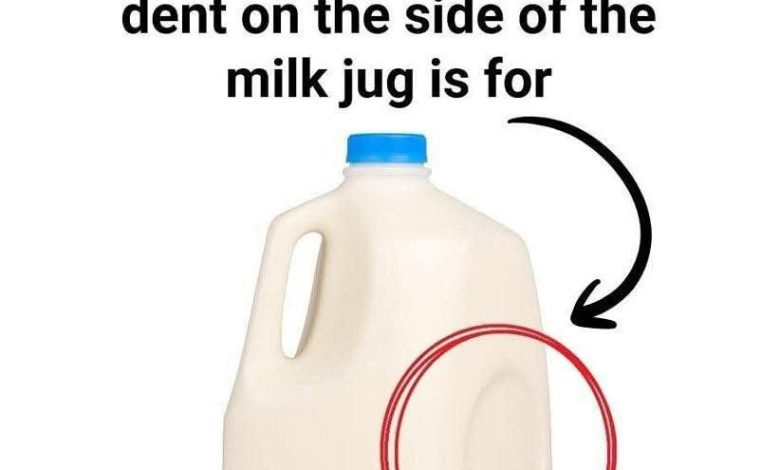
Purpose of the Circular Dent on Milk Jugs..
Most of us have noticed that small, round indentation on the side of a plastic milk jug. I’ll admit it—I’ve stared at that little mystery circle more times than I can count. You know the one: the pushed-in circle that seems like it might be a factory slip-up or maybe even decorative. But it’s neither. That little dent has a very real—and very clever—purpose.
So, grab your cereal, pour some milk, and let’s reveal exactly why that dent exists.
3 Big Reasons the Milk Jug Dent Exists
That indentation isn’t an accident. It’s an intentional part of the jug’s design, created for safety, durability, and strength.
1. It Helps Manage Pressure
Milk is a liquid, and liquids react to temperature changes. Since milk has to stay cold, any shift in temperature—like going from a warm delivery truck to a cold fridge—causes the liquid to expand or contract.
The circular dent acts as a flexible pressure zone. It can push outward slightly when the milk expands.
Without it, the jug could bloat, crack, or even burst (especially if the milk freezes). The dent gives the plastic room to adjust—like the jug’s built-in stress reliever.
2. It Reduces Spills
Ever dropped a jug of milk? Same here.
That dent also works like a shock absorber. If the jug gets bumped or dropped during transport, stocking, or grocery-store handling, the indentation helps absorb the impact.
This lowers the risk of cracks and leaks—saving you from a messy kitchen disaster and saving companies money from damaged products.
3. It Strengthens the Jug Without Extra Plastic
The dent is an engineering shortcut that adds durability without increasing plastic use.
Think of the support arches in architecture—they add strength using shape, not weight.
The indentation reinforces the structure of the jug, allowing it to stay sturdy while remaining lightweight and inexpensive to produce. Clever, efficient design at its best.
⚠️ A Warning Sign for Spoiled Milk
Here’s an interesting twist: sometimes, if milk spoils, bacteria inside the jug produce gas. This gas builds pressure and can cause the dent to bulge outward.
If you notice a milk jug where the dent is puffed out or looks strange, take it seriously—it may be a sign the milk has turned.
(Not every bulge means spoiled milk, but it’s a good early warning.)
Why a Circle?
Why choose a circular shape instead of a square or triangle?
Circles handle pressure best. With no sharp corners to concentrate stress, pressure distributes evenly around the edge. That makes the circle perfect for an area designed to flex with temperature changes and handling.
Plus, circles are easy to manufacture consistently. Simple, strong, and efficient.
Other Clever Milk Jug Details
While we’re appreciating smart design, here are a few more things you might not have noticed:
- Handle Hole: Not just for grip—removing plastic here reduces material use.
- Bottom Ridges: Those bumps on the base help the jug sit evenly, even on slightly uneven shelves.
- Cap Colors: Many brands use cap colors to signal fat content (like blue for 2% or red for whole milk).
It’s pretty amazing how much thought goes into something we barely notice.




